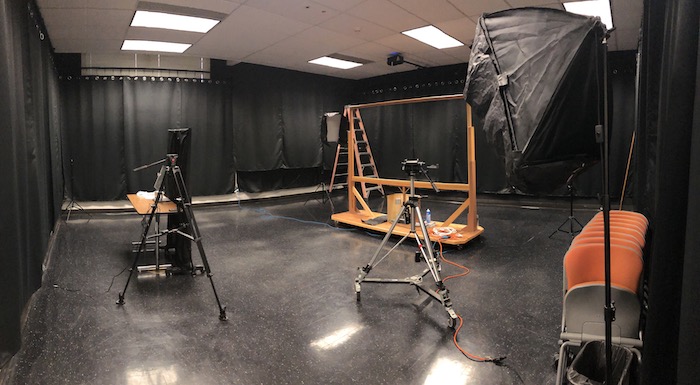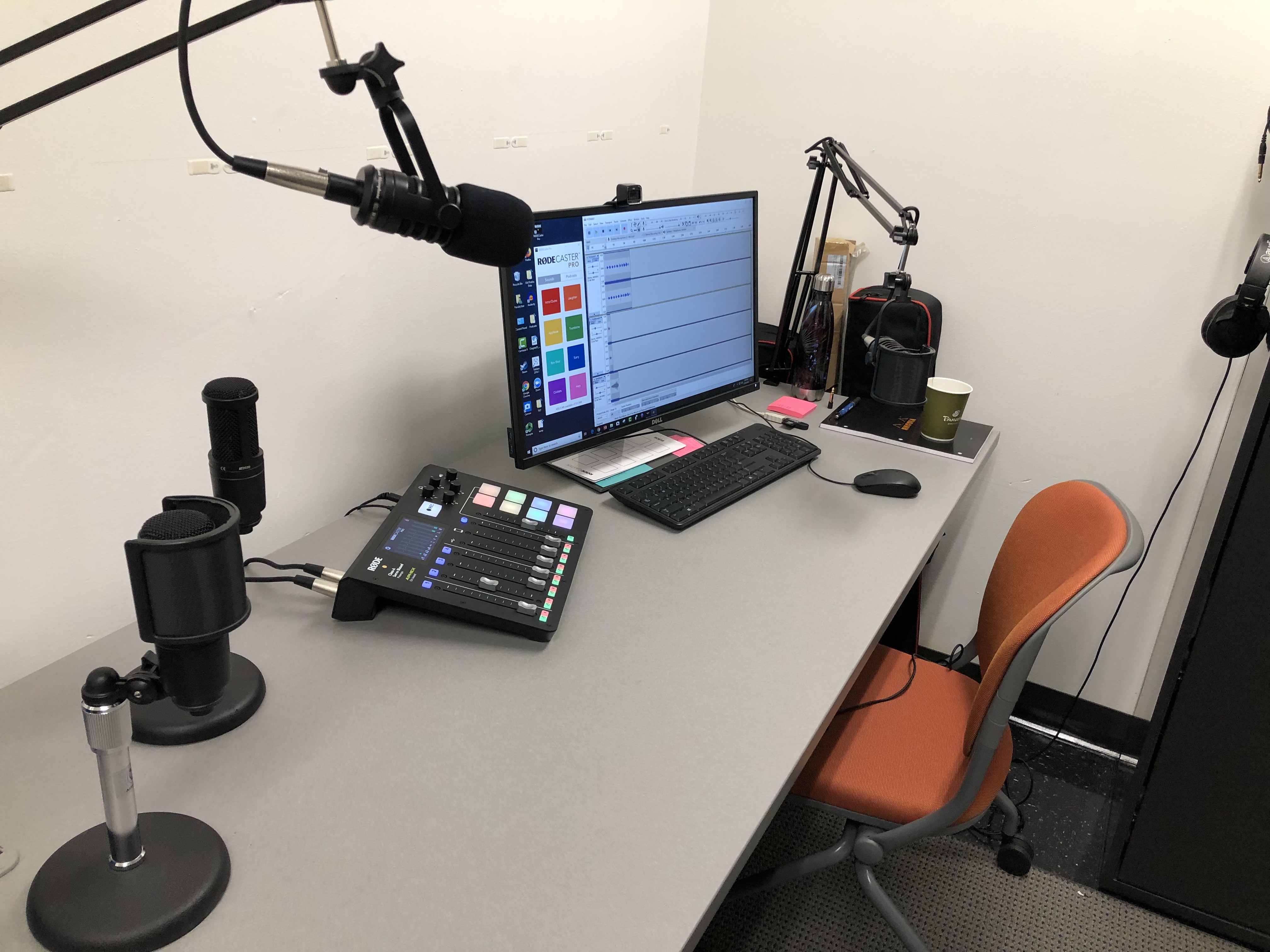Oregon State University – LXD: Advanced Tools & E-Learning Trends
June 3 – July 21, 2019
Overview
Many of our faculty have expressed interest in podcasting as a way of adding another, portable element to their course. Most of the interest surrounds the creation of content that students can access on the move when commuting to class from devices such as their phones. As the Director of eLearning, it is my role to lead the team who supports faculty in these endeavors and teach them pedagogically sound practices for doing so. Therefore, my team and I decided to create a podcast that focuses on innovative ways to solve instructional problems. As a part of this project, we hope to create a model podcast, handouts that guide faculty in how to do this both technically and pedagogically and provide a studio setting with equipment to do it in. Since this project started, we have also decided to create an Introduction to Podcasting Course for our faculty as well.
I imagine that objectives for that course might look something like the following:
After completion of this training, learners will be able to…
- Define podcast in their own words.
- Podcast vs. Vodcast
- Align a pedagogical rationale for using podcasts in their classroom to their learning objectives.
- Develop a podcast structure in alignment with their instructional objectives.
- Create a sample podcast with intro/outro music
- Identify tools and equipment needed for creating a podcast.
- Locate and download intro/outro music to the podcast.
- Use Audacity to record and edit the podcast.
- Choose a server to host their podcast.
- Share the RSS feed link to their podcasts with others.
Audience
Higher Education Faculty
Space & Equipment
We were fortunate enough to be able to acquire space within our facility and turn it into a video/audio recording studio. It comes with two side post-production rooms where we can record or edit as well – pictured below.
For podcasting, we have ordered the Rodecaster-Pro Bundle with four mics, cables, positionable stands, and headsets.
Production
Being the organizational freak that I am, I wanted to make sure we did this right. So, I called an initial production meeting last week. At our first meeting, we discussed the purpose, target audience, potential structure, and topics. Because I don’t want to start something we are not serious about, I said we wouldn’t go live with our first edition until we had recorded at least 12 of the first 24 episodes. We hope to record these over the summer and begin releasing in the Fall. Things we are to bring to our next meeting include potential names, topics, and ideas for intro/outro music, Logo, marketing, etc.
At our second production meeting we worked on Podcasts structure (segments), name, and example topics. We decided that we were going to let the topics more organically develop by asking faculty to share challenges and successes with us. The general structure will be as follows:
Draft Title
Solving Instructional Problems, with Justin Time
Structure
- 2 episodes per month, on the 1stand 3rdMondays.
- 1stMonday: Full episode, exploring an instructional problem, identifying both pedagogical and technical solutions with faculty. Visual companion that includes a video demonstrating the tool and resources for further reading.
- 3rdMonday: Condensed episode, exploring how to incorporate various topics into a class, with instructors doing that work. Center around current & upcoming issues, themes, and campus events.
Segments
- Introduction (3 minutes): Provide the audience with the vodcast/producer identification reinforcing the program recognition and the “fan” base.
- Podcast intro, music, hook and tagline
- Episode intro, with faculty member present and present the problem
- Ask faculty member to introduce themselves to the listener (what they teach, a little about themselves, and their learning environments)
- Define problem with SME (3-5 minutes): Lay out the problem elements for the listeners to connect with their own experience. Invite the listeners to identify themselves in the problem and start visualizing the situation.
- We presented the problem in the introduction
- We ask the SME to tell us more about the problem, including how they have experienced it within their own classes
- We ask the SME about the impact of the problem on students and faculty alike
- Questions for the SME:
- Can you tell us more about what this problem is?
- How have you experienced this in your classroom?
- How did you notice the problem was occurring?
- Why is this a problem?
- What is the impact of this problem, and who does it impact (students, instructors, or both)?
- SME Solution (8-10 minutes): Present the SME’s solution using the 5W1H approach demonstrating the problem-solving process, the rational, and the outcomes. The listeners have an opportunity to compare them with their own situations, and they may and may not fully associate with the SME’s solution.
- We ask the SME how they’ve solved the problem within their own classes, and let them take us through their process
- We ask if the solution worked or not, and what did they learn from it either way
- We ask the SME for any advice they might give to other faculty trying to implement the solution
- Questions for the SME:
- Please summarize for everyone the solution you implemented
- How did you identify the solution (for example, what resources did you refer to, did you consult with peers, etc.?)
- Why did you choose this particular solution to implement?
- Did this resolve the problem in your class, and how could you tell?
- What challenges did you face in implementing this solution?
- What advice do you have for anyone else wrestling with this problem?
- Any suggestions on putting your solution into practice for instructors from different disciplines, or who teach in different learning environments?
- Tool Presentation (7-10 minutes): Regroup and align the conversation to the tools and solutions that the podcast series plans to cover in 12 episodes. This segment may include tools not covered in the SME Solution section to provide more general solutions.
- We present a particular tool that we feel can help solve the problem
- We talk about why the tool was chosen and what it can do to help with the problem
- We talk about any challenges or considerations when using the tool
- If SME used the tool, we ask them for any suggestions they might have
- Visual companion should include a video demonstrating using the tool, created in conjunction with the SME, when possible
- Presenter to include:
- Which tool was chosen, and why
- What considerations should an instructor make when using this tool?
- What are the benefits of using the tool?
- What are the challenges of using the tool?
- What resources are available to instructors using the tool?
- Q&A (2-3 minutes): Provide listener participation to the current and the next episode. Connect the listeners and the SME.
-
- Solicit questions on the topic in advance (for the current or next episode?)
- Include SME for Q&A
-
- Acknowledgements & Closer (1 minute): Provide a hook to the next episode. Create a sense of community.
-
- Thank the SME for presenting
- Thank the listener for tuning in
- Preview the next episode
-

